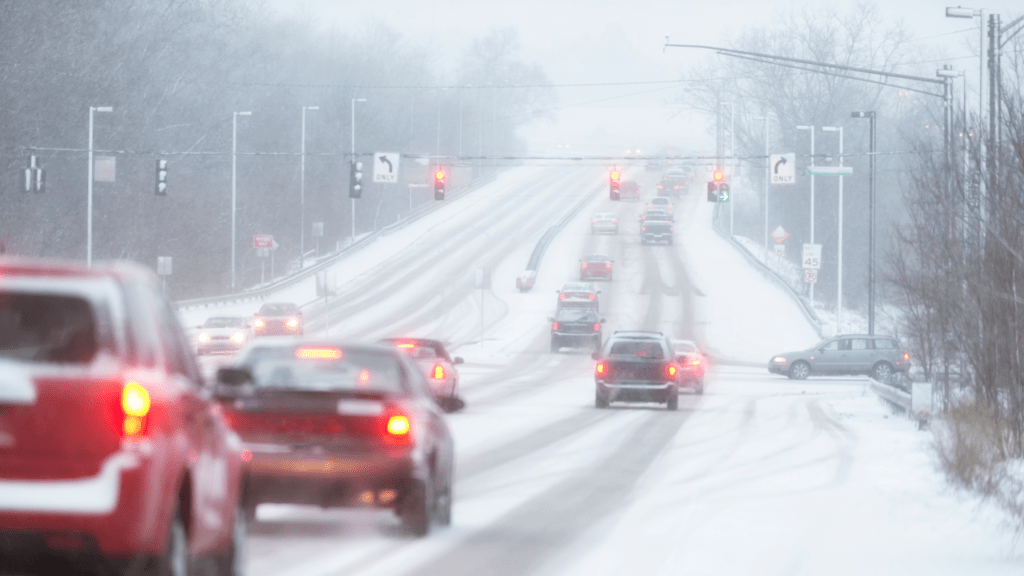As winter approaches, it’s crucial to be prepared for the challenges (e.g. a traffic accident) that come with driving on snowy and icy roads. Every year, thousands of traffic accidents occur due to the hazardous conditions brought on by winter weather. In this article, we’ll explore the main causes of winter traffic accidents, including icy roads, snowy conditions, reduced visibility, and the treacherous black ice. We’ll also delve into essential tips on how to prepare your vehicle for winter driving, such as checking your tires, testing your battery, inspecting your brakes, and topping off your fluids. We’ll discuss the crucial items to keep in your car for winter driving, such as a snow shovel, ice scraper, blankets, and an emergency kit. We’ll provide valuable insights on how to drive safely on winter roads, including tips on slowing down, increasing following distance, using headlights, avoiding sudden movements, and knowing how to handle skids. By the end of this article, you’ll be equipped with the knowledge and tools to navigate winter roads safely and minimize the risk of traffic accidents. Stay tuned for essential information on preventing traffic accidents and handling winter driving challenges in 2024.
What are the Main Causes of A Winter Traffic Accident?
Winter traffic accidents can be caused by various factors, including icy roads, snowy conditions, reduced visibility, and black ice.
Icy roads pose a significant risk as they reduce the tire’s grip on the pavement, leading to slippery conditions and reduced control over the vehicle. Snowy conditions not only impair visibility but also create obstacles on the road, increasing the chances of collisions and skidding. Reduced visibility, often caused by snow or fog, can make it challenging for drivers to anticipate and react to hazards. Black ice, being practically invisible, adds a hidden danger, causing sudden loss of traction and control.
Icy Roads
Icy roads pose a significant hazard during winter, increasing the risk of accidents and requiring vigilance and caution from all drivers.
Black ice and snow-covered roads contribute to decreased traction, leading to skidding and loss of vehicle control. In such conditions, it’s crucial to reduce speed, increase following distance, and avoid sudden maneuvers. Chicago bus accident lawyer professionals stress the importance of maintaining the vehicle in optimal condition, with well-inflated tires and functioning brakes being essential.
Staying informed about weather forecasts and road conditions before heading out can help drivers make informed decisions and minimize the risk of accidents.
Snowy Roads
Snowy roads can lead to reduced traction and control, contributing to an elevated likelihood of car accidents, necessitating attentiveness and defensive driving strategies.
When encountering snowy road conditions, it’s crucial for drivers to adjust their driving behavior accordingly. Decreased visibility and slippery surfaces demand increased following distances and reduced speeds. By taking these precautions, drivers can allow for ample reaction time and minimize the risk of skidding or losing control.
It’s also advisable to equip vehicles with proper winter tires and ensure they are in optimal condition. Maintaining a well-stocked emergency kit and staying informed about weather forecasts can further enhance preparedness for navigating through snowy roads. With a focus on caution and foresight, drivers can better safeguard themselves and other road users from potential accidents.
Reduced Visibility and A Winter Traffic Accident
Reduced visibility during winter can impede the ability to anticipate and react to potential hazards on the road, emphasizing the need for heightened awareness and precautionary measures.
When navigating through foggy conditions, drivers often encounter significant challenges in accurately gauging distances, interpreting road signs, and maintaining a clear line of sight. This creates a critical imperative to adapt driving habits, such as reducing speed, increasing following distances, and using fog lights to enhance visibility.
Seeking the expertise of the best auto accident lawyer in Chicago could provide invaluable legal support in the unfortunate event of an accident caused by reduced visibility.
Winter Traffic Accident and Black Ice
Black ice, often indiscernible to drivers, presents a stealthy threat, requiring drivers to exercise extreme care and adapt their driving behavior to avoid potential accidents.
During winter months, black ice forms on road surfaces, especially in shaded or less-traveled areas. Its transparent nature makes it nearly invisible, catching drivers off guard. This hazardous condition can lead to skidding and loss of vehicle control, resulting in collisions and injuries. To navigate these treacherous conditions, experts recommend reducing speed, maintaining a safe following distance, and avoiding sudden maneuvers. Being aware of temperature drops and staying cautious in potential icy spots are crucial to prevent accidents. Seeking legal help from experienced accident injury lawyers in Chicago may become necessary if you encounter unfortunate incidents caused by black ice-related accidents.
Avoid a Traffic Accident: How to Prepare Your Vehicle for Winter Driving?
Preparing your vehicle for winter driving involves essential maintenance steps to ensure optimal performance and safety in challenging weather conditions and overall, avoid a traffic accident.
Start by checking your tires to ensure proper inflation and tread. Cold weather can cause tire pressure to decrease, affecting traction and stability. Consider switching to winter tires for better grip in snowy and icy conditions.
Inspect your vehicle’s battery, fluids, and brakes to make sure they are in good condition. Keeping a winter emergency kit in your car is also essential, including items like a flashlight, extra warm clothing, and a small shovel.
Check Your Tires
Tire condition is crucial for winter driving, necessitating regular inspections, proper inflation, and the consideration of snow or winter tires for enhanced traction.
Winter driving in Chicago can be particularly challenging due to snow, ice, and low temperatures which can lead to a traffic accident. Maintaining well-conditioned tires is essential to ensure safety on the roads. Tire pressure tends to drop in colder weather, so it’s important to check and adjust it regularly. Investing in snow or winter tires can significantly improve grip and control, reducing the risk of accidents, particularly in slippery conditions.
It’s also crucial for truck drivers to seek guidance from a reputable Chicago truck accident lawyer in case of any legal issues related to road safety and accidents.
Test Your Battery
A reliable battery is essential for winter driving, prompting the need for battery testing, maintenance, and potential replacements to avoid unexpected breakdowns.
Cold temperatures can significantly impact battery health, leading to reduced power output and slower engine starts. Regular battery testing, especially in colder climates, can help identify any potential issues before they escalate. Simple maintenance tasks such as cleaning the battery terminals and ensuring proper insulation can also contribute to prolonged battery life.
It’s crucial to keep an eye on the battery health indicators and seek professional assistance for replacement if necessary. This preemptive approach can prevent pedestrian accidents and ensure a smoother driving experience during the winter months.
Check Your Brakes
Brake systems require thorough inspection and maintenance to ensure reliable stopping power and responsiveness in winter driving conditions, emphasizing the need for proactive brake checks.
Winter driving brings forth challenges such as icy roads and decreased visibility, making it crucial to have brake systems in top-notch condition to avoid unnecessary risks. Regular checks can help identify worn brake pads, leaky brake lines, or low brake fluid levels that can compromise the safety of the vehicle and can cause a traffic accident.
Seeking the assistance of a reputable Chicago car accident attorney can provide legal guidance in case of accidents caused by malfunctioning brake systems.
Top Off Your Fluids
Fluid levels, including antifreeze, windshield washer fluid, and engine oil, should be topped off to ensure optimal vehicle performance and protection against winter-related issues.
In colder weather conditions, maintaining the right levels of antifreeze is crucial to prevent engine freezing or overheating. Regularly checking and replenishing windshield washer fluid is essential for visibility during snow or sleet. Ensuring the engine oil is at the recommended level provides crucial lubrication for the engine components, especially during colder temperatures.
To avoid a traffic accident, regularly checking these fluids can help prevent potential issues while driving in winter. In unfortunate situations, like an auto accident, seeking legal assistance, such as an auto accident lawyer near Chicago, is advisable for appropriate legal guidance and support.
What are the Essential Items to Keep in Your Car for Winter Driving?
Equipping your vehicle with essential items for winter driving can enhance safety and preparedness, ensuring readiness for potential challenges on the road.
Winter driving can bring frigid temperatures, icy roads, and low visibility, making it crucial to have the right gear at hand. A scraper and brush are must-haves for clearing ice and snow from windows and lights, while a foldable shovel can help dig out your car if needed. It’s equally vital to have a basic toolkit and a tire pressure gauge to address any mechanical issues that may arise in the cold.
Additionally, extra blankets, warm clothing, and a first-aid kit are essential for comfort and safety in case of an emergency.
Snow Shovel
A snow shovel is a vital tool for clearing snow and ice around your vehicle, enabling safe passage and preventing potential obstructions during winter driving.
Not only does it help to ensure clear visibility and accessibility to your car, but it also plays a crucial role in minimizing the risks of accidents and mishaps on the road. By efficiently removing accumulated snow around the tires and areas near the vehicle, a snow shovel reduces the chances of slipping and sliding when entering or exiting your car.
In case of emergency situations, such as getting stuck in a snowbank, having a snow shovel on hand can be invaluable. When utilized properly, it can assist in digging out the car and creating a pathway for the tires to regain traction, potentially averting the need for external assistance.
Considering the unpredictable nature of winter weather, incorporating a reliable snow shovel in your vehicle’s emergency kit offers a prudent approach to enhance safety and preparedness for navigating the challenging road conditions that can cause a traffic accident.
Ice Scraper
An ice scraper is essential for clearing ice from windows and windshields, ensuring clear visibility and safe driving in wintry conditions.
During winter, the accumulation of ice and frost on car windows poses a significant safety hazard, limiting the driver’s visibility and increasing the risk of accidents. By using an ice scraper to remove this obstructive layer, drivers can enhance safety on the road. It’s crucial for motorists, especially in regions with harsh winter weather such as Chicago, to have a reliable ice scraper in their vehicle.
When selecting an ice scraper, consider one with a durable blade and a comfortable grip for efficient and effortless ice removal. Having a compact and portable design is beneficial, allowing for convenient storage in the car.
Blankets
Blankets provide warmth and comfort in case of emergencies or extended waits during winter driving situations, offering essential insulation and protection against cold weather.
Having a blanket in your vehicle can greatly enhance your safety and preparedness during unforeseen events on the road. In case of an accident or a breakdown in harsh winter conditions, a blanket can provide crucial warmth until help arrives, reducing the risk of hypothermia and frostbite.
It’s not just about comfort; it’s an important safety measure that can make a significant difference in mitigating the impact of unforeseen circumstances. That’s why it’s always recommended to keep a sturdy blanket in your emergency kit for winter driving, ensuring you are well-prepared for any unexpected situations on the road.
Emergency Kit
An emergency kit containing first aid supplies, non-perishable food, and basic tools is crucial for addressing unforeseen situations and ensuring safety during winter driving.
While driving during winter, especially in areas like Chicago where weather conditions can be harsh, encountering unexpected situations such as getting stranded due to snow or experiencing vehicle malfunctions can occur. In such scenarios, having an emergency kit can be a lifesaver.
- The first aid supplies can help in providing immediate assistance for any injuries sustained in an accident, offering a crucial first response before professional help arrives
- The non-perishable food provides sustenance in case of being stranded for an extended period, ensuring that individuals can maintain their energy levels
- Basic tools, such as a multi-tool or tire repair kit, can assist in making quick repairs and adjustments, allowing individuals to address minor issues and continue their journey safely
It’s crucial to remember that these items are essential for motorcyclists as well, given that they are more vulnerable to the elements and can face additional challenges on the road. This makes the presence of an emergency kit even more crucial, especially in the context of potential accidents, where the expertise of a Chicago motorcycle accident attorney may be necessary to navigate legal proceedings and seek compensation for injuries or damages sustained.
How to Drive Safely on Winter Roads and Avoid a Traffic Accident?
Safe driving on winter roads demands heightened caution, adaptability, and awareness of specific strategies to mitigate the risks associated with wintry conditions.
Being aware of black ice and reducing speed when approaching shaded areas can prevent dangerous skidding. It’s also essential to keep a safe following distance from other vehicles and not to engage in sudden braking or acceleration, especially on slippery surfaces.
Clearing snow and ice from all windows, lights, and mirrors is vital for visibility, and always checking weather and road conditions before traveling is crucial for safe driving in winter. Defensive driving techniques, such as anticipating potential hazards and maintaining a calm, focused mindset, are also essential strategies to navigate wintry roads safely.
Slow Down and Increase Following Distance
Reducing speed and maintaining increased following distances are essential precautions for safe driving on winter roads, allowing for enhanced response time and maneuverability.
Driving at a reduced speed ensures better control over the vehicle and affords the opportunity to react to unexpected obstacles or slippery patches on the road. Maintaining a greater following distance from the vehicle ahead provides ample time to stop or change course in case of sudden pedestrian crossings or unforeseen hazards. This precaution becomes even more critical when navigating through urban areas, where the expertise of a seasoned pedestrian accident lawyer in Chicago can prove invaluable in dealing with complex legalities.
Use Your Headlights
Proper headlight usage, including low beams in foggy conditions, is crucial for visibility and ensuring that your vehicle is visible to others on the road during winter driving.
Using headlights not only helps you see the road and potential hazards, but properly illuminated vehicles also play a pivotal role in others’ ability to see you, reducing the risk of accidents. In Chicago, where inclement weather and reduced visibility are common during winter, being proactive about headlight maintenance and usage is even more essential.
Consulting with a knowledgeable professional, such as a Chicago car accident attorney, can also provide valuable insights and steps to take in the event of a weather-related car accident.
Avoid Sudden Movements
Minimizing sudden movements, such as sharp turns and abrupt braking, is essential for maintaining vehicle control and stability on winter roads, reducing the risk of accidents.
When driving on slippery or snow-covered roads, maintaining a smooth and controlled driving style is crucial to ensure safety for both the driver and other road users. By anticipating the road conditions ahead and gradually adjusting your speed and steering inputs, you can reduce the likelihood of skidding or losing control of the vehicle.
Leaving ample distance between your vehicle and the one in front of you allows for sufficient reaction time, especially in case of unexpected hazards. Practicing gentle acceleration and braking techniques can significantly minimize the risk of sliding or hydroplaning, enhancing overall driving stability in winter conditions.
Know How to Handle Skids
Understanding skid recovery techniques and practicing controlled responses is vital for mitigating the risks of skidding on icy or slick surfaces during winter driving.
When encountering a skid, maintaining calmness and focus is crucial to regain control. It’s important to steer gently in the direction you want to go without overcorrecting, allowing the tires to regain traction. Adopting proper tire maintenance, ensuring adequate tread depth, and using appropriate tires for winter conditions are fundamental in preventing skids.
Expert advice from a Chicago bus accident lawyer can also provide insights into legal aspects related to accidents caused by skidding on icy roads.
Frequently Asked Questions
What are some common causes of a traffic accident on winter roads?
Some common causes of traffic accidents on winter roads include icy or slippery road conditions, reduced visibility due to snow or fog, and drivers not adjusting their speed or driving habits for winter weather.
How can I prepare my car for driving on winter roads?
To prepare your car for driving on winter roads, you should make sure your tires have adequate tread and are properly inflated, have your brakes and heating system checked, and keep a winter emergency kit in your car with items like a shovel, ice scraper, and blankets.
What should I do if I start to skid on an icy road?
If you start to skid on an icy road, the most important thing to do is to remain calm and avoid overcorrecting. Steer in the direction you want the car to go and gently apply the brakes. If you have anti-lock brakes, apply steady pressure to the brake pedal.
How can I avoid a traffic accident caused by reduced visibility?
To avoid a traffic accident caused by reduced visibility, make sure your headlights and windshield wipers are working properly and use them as needed. Also, leave extra space between you and the car in front of you, especially if you can’t see well due to snow or fog.
Are there any specific traffic laws I should be aware of when driving on winter roads?
Some states may have specific laws for driving on winter roads, such as requiring snow tires or chains, or mandating a lower speed limit during winter weather. It’s important to familiarize yourself with these laws and follow them to prevent accidents.
What should I do if I witness a traffic accident on a winter road?
If you witness a traffic accident on a winter road, the first thing to do is call 911 for emergency assistance. If it is safe to do so, try to assist any injured individuals and provide information to emergency responders. Otherwise, wait for help to arrive and avoid becoming involved in the accident yourself.





